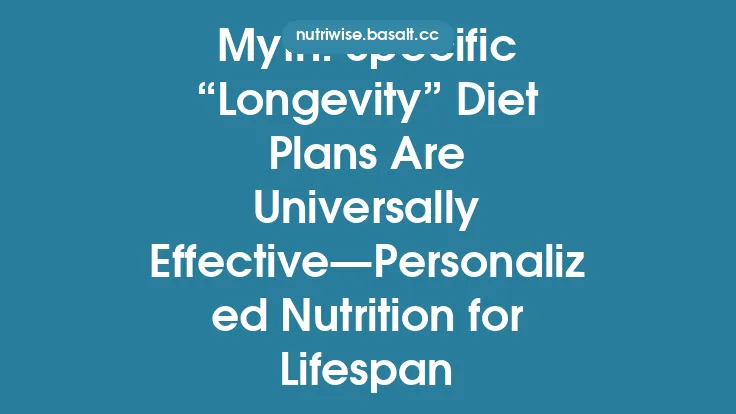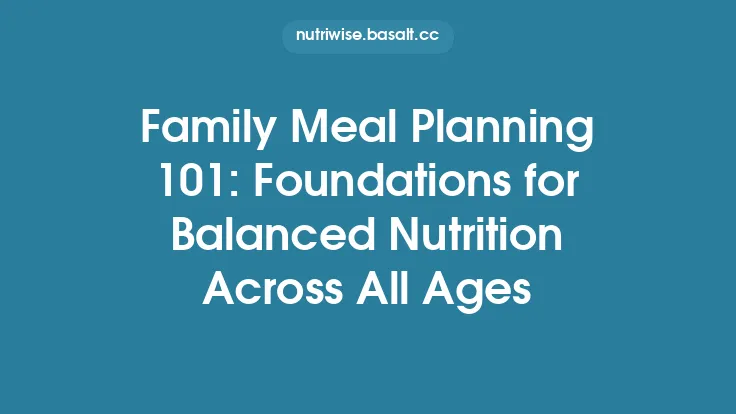Athletes’ nutritional needs evolve dramatically as they progress through different phases of life. While the core principles of performance nutrition—adequate energy, optimal macronutrient distribution, and strategic micronutrient timing—remain constant, the way these principles are applied must be tailored to the physiological, hormonal, and lifestyle changes that accompany each age bracket. This article walks through the distinct nutritional considerations for athletes at every major life stage, offering practical meal‑planning strategies, sample food combinations, and evidence‑based guidelines that can be adapted to a wide range of sports, training intensities, and personal preferences.
1. Early‑Development Athletes (Ages 5‑12)
Physiological Context
- Growth Spurts: Rapid linear growth and skeletal development increase basal metabolic rate (BMR) by 10‑20 % compared with sedentary peers.
- Neuromuscular Maturation: Motor skill acquisition and coordination improve with practice, demanding both energy and specific nutrients for neural health.
- Energy Expenditure: Structured practice sessions (1‑2 h) plus spontaneous play can raise total daily energy expenditure (TDEE) to 2,200‑2,800 kcal for active boys and 2,000‑2,500 kcal for active girls.
Macronutrient Priorities
| Nutrient | Recommended Range | Rationale |
|---|---|---|
| Carbohydrates | 5‑7 g · kg⁻¹ body weight · day⁻¹ | Primary fuel for high‑intensity bursts; supports glycogen repletion after training. |
| Protein | 1.2‑1.5 g · kg⁻¹ body weight · day⁻¹ | Supports muscle protein synthesis (MPS) during growth; higher end for strength‑oriented sports. |
| Fat | 30‑35 % of total kcal | Essential fatty acids (omega‑3) aid brain development and inflammation control. |
Micronutrient Highlights
- Calcium (1,300 mg/day) and Vitamin D (600‑800 IU/day) for bone mineralization.
- Iron (11‑15 mg/day) especially for girls; monitor ferritin to prevent iron‑deficiency anemia.
- Zinc (5‑8 mg/day) and Magnesium (130‑240 mg/day) for enzymatic reactions in energy metabolism.
Meal‑Timing Blueprint
- Pre‑Practice (60‑90 min before): Light carbohydrate‑rich snack (e.g., banana + whole‑grain toast) + 5‑10 g protein.
- During Practice (≥90 min): Small carbohydrate source (e.g., diluted fruit juice or sports drink) if intensity is high.
- Post‑Practice (within 30 min): 1:3 protein‑to‑carbohydrate ratio (e.g., chocolate milk, Greek yogurt with honey and berries) to maximize glycogen restoration and MPS.
Sample Day
- Breakfast: Oatmeal cooked in milk, topped with sliced almonds, blueberries, and a drizzle of honey.
- Mid‑Morning Snack: Apple slices with peanut butter.
- Lunch: Grilled chicken wrap with whole‑wheat tortilla, mixed greens, shredded carrots, and avocado; side of quinoa salad.
- Afternoon Snack (pre‑practice): Whole‑grain crackers with hummus and a small orange.
- Post‑Practice Recovery: Low‑fat chocolate milk + a banana.
- Dinner: Baked salmon, sweet potato mash, steamed broccoli, and a mixed fruit salad.
- Evening Snack: Cottage cheese with pineapple chunks.
2. Adolescent Athletes (Ages 13‑19)
Physiological Context
- Pubertal Hormonal Shifts: Increases in testosterone, estrogen, and growth hormone amplify protein turnover and lean‑mass accretion.
- Variable Training Loads: Competitive seasons, off‑season conditioning, and academic demands create fluctuating energy needs.
- Risk of Energy Deficiency: High training volume combined with body‑image pressures can lead to Relative Energy Deficiency in Sport (RED‑S).
Macronutrient Priorities
- Carbohydrates: 6‑10 g · kg⁻¹ body weight · day⁻¹, adjusted upward during heavy training blocks or tournaments.
- Protein: 1.4‑1.7 g · kg⁻¹ body weight · day⁻¹; emphasis on high‑quality sources (lean meats, dairy, legumes, soy).
- Fat: 25‑30 % of total kcal; prioritize monounsaturated and polyunsaturated fats for hormone synthesis.
Micronutrient Highlights
- Iron: 15‑18 mg/day for males, 18‑20 mg/day for females; consider iron‑rich foods (red meat, lentils) and vitamin C pairing for absorption.
- Calcium & Vitamin D: Same as early‑development athletes, but ensure adequate intake to support rapid bone growth.
- B‑Vitamins: Crucial for energy metabolism; include whole grains, eggs, and leafy greens.
Periodized Nutrition Strategies
| Phase | Energy Focus | Carbohydrate Timing | Protein Emphasis |
|---|---|---|---|
| Pre‑Season (strength building) | Slight caloric surplus (+5‑10 %) | Moderate‑high carbs before heavy lifts | 1.6 g · kg⁻¹ day⁻¹ split across meals |
| In‑Season (competition) | Match‑day fueling; maintain weight | High‑glycemic carbs 2‑3 h pre‑event; intra‑event carbs if >90 min | 1.5 g · kg⁻¹ day⁻¹; post‑event 20‑30 g protein |
| Off‑Season (recovery) | Slight deficit if body‑composition goal | Lower carbs (4‑5 g · kg⁻¹) | Maintain 1.4 g · kg⁻¹ day⁻¹ to preserve lean mass |
Sample Day (High‑Intensity Training)
- Breakfast: Whole‑grain pancakes topped with Greek yogurt, mixed berries, and a sprinkle of chia seeds.
- Mid‑Morning Snack: Trail mix (almonds, pumpkin seeds, dried apricots) + a protein bar (≈20 g protein).
- Lunch: Turkey and avocado sandwich on sprouted‑grain bread, side of quinoa tabbouleh, and a carrot‑cucumber salad.
- Pre‑Practice Snack (90 min): Low‑fat chocolate milk + a banana.
- During Practice (if >90 min): Sports drink providing 30‑45 g carbs.
- Post‑Practice Recovery: Whey protein shake (25 g) blended with frozen mango, spinach, and oat milk.
- Dinner: Stir‑fried tofu with brown rice, bell peppers, snap peas, and a ginger‑soy glaze.
- Evening Snack: Cottage cheese with sliced kiwi and a drizzle of honey.
3. Young Adult Athletes (Ages 20‑35)
Physiological Context
- Peak Aerobic and Anaerobic Capacity: VO₂max and muscle power typically reach their zenith.
- Training Specialization: Athletes often focus on a single sport or position, requiring sport‑specific nutrient timing.
- Lifestyle Variability: Travel, work schedules, and social commitments can disrupt regular eating patterns.
Macronutrient Priorities
- Carbohydrates: 5‑7 g · kg⁻¹ day⁻¹ for endurance athletes; 7‑10 g · kg⁻¹ day⁻¹ for high‑intensity or weight‑class sports.
- Protein: 1.6‑2.0 g · kg⁻¹ day⁻¹; distribute evenly (≈0.3‑0.4 g · kg⁻¹ per meal) to sustain MPS.
- Fat: 20‑30 % of total kcal; include omega‑3 fatty acids (EPA/DHA 1‑2 g/day) for anti‑inflammatory benefits.
Micronutrient Highlights
- Electrolytes (Na⁺, K⁺, Mg²⁺, Ca²⁺): Critical for muscle excitability; replace via sports drinks or food (e.g., bananas, nuts, dairy).
- Vitamin C & E: Antioxidant support; moderate intake (≥90 mg vitamin C, 15 mg vitamin E) to aid recovery without blunting training adaptations.
- Vitamin B12 & Folate: Energy production; especially important for vegetarian/vegan athletes.
Advanced Timing Techniques
- Carb‑Periodization: Align carbohydrate intake with training intensity—high‑carb days on heavy load, low‑carb days on recovery or skill sessions.
- Protein Pulse Feeding: 4‑6 feedings of 20‑30 g protein spaced 3‑4 h apart to keep leucine levels above the anabolic threshold.
- Pre‑Sleep Nutrition: 30‑40 g casein protein + 0.5 g · kg⁻¹ carbs 30 min before bed to promote overnight MPS and glycogen storage.
Sample Day (Mixed‑Modality Athlete)
- Pre‑Workout (30 min): 30 g whey isolate mixed with 250 ml water + 1 g creatine monohydrate.
- During Workout (≥60 min): 6 % carbohydrate-electrolyte solution (≈30 g carbs per hour).
- Post‑Workout (within 20 min): 25 g whey + 40 g maltodextrin + 5 g glutamine shake.
- Breakfast: Scrambled eggs with spinach, whole‑grain toast, and a side of mixed fruit.
- Mid‑Morning Snack: Greek yogurt with honey and a handful of walnuts.
- Lunch: Grilled salmon, wild rice pilaf, roasted Brussels sprouts, and a mixed greens salad with olive‑oil vinaigrette.
- Afternoon Snack (pre‑training): Oatmeal bar + a small orange.
- Dinner: Lean beef stir‑fry with bell peppers, bok choy, and soba noodles; miso soup.
- Evening Snack (pre‑sleep): Cottage cheese (200 g) with sliced peach and a sprinkle of cinnamon.
4. Mid‑Career Adult Athletes (Ages 36‑50)
Physiological Context
- Gradual Decline in Hormonal Anabolism: Testosterone and growth hormone levels begin to taper, affecting muscle protein synthesis and recovery speed.
- Increased Injury Susceptibility: Tendon elasticity and joint cartilage experience wear, necessitating anti‑inflammatory nutrition.
- Metabolic Shifts: Resting metabolic rate (RMR) may drop 1‑2 % per decade, making energy balance more nuanced.
Macronutrient Priorities
- Carbohydrates: 4‑6 g · kg⁻¹ day⁻¹; prioritize low‑glycemic sources to maintain stable blood glucose.
- Protein: 1.8‑2.2 g · kg⁻¹ day⁻¹; higher end for strength‑maintaining athletes.
- Fat: 30‑35 % of total kcal; emphasize omega‑3s (≥2 g EPA/DHA) and monounsaturated fats for joint health.
Micronutrient Highlights
- Vitamin D (800‑1,000 IU/day) and Calcium (1,200 mg/day) to counteract age‑related bone loss.
- Collagen‑Supporting Nutrients: Vitamin C (≥200 mg/day), proline‑rich foods (gelatin, bone broth), and hyaluronic acid sources (citrus, leafy greens).
- Magnesium (350‑420 mg/day) for muscle relaxation and sleep quality.
Recovery‑Focused Strategies
- Periodized Protein: 0.4 g · kg⁻¹ per meal, with a dedicated “recovery meal” containing 30‑40 g high‑quality protein + 0.5 g · kg⁻¹ carbs within 2 h post‑exercise.
- Anti‑Inflammatory Protocol: Daily omega‑3 supplementation, turmeric/curcumin (500 mg with black pepper extract), and regular intake of polyphenol‑rich berries.
- Sleep‑Nutrition Link: Incorporate magnesium‑rich foods (pumpkin seeds, dark chocolate) and tryptophan‑rich proteins (turkey, dairy) in the evening to improve sleep architecture.
Sample Day (Strength‑Endurance Athlete)
- Breakfast: Protein‑rich smoothie (whey, kefir, frozen berries, spinach, flaxseed) + a slice of sprouted‑grain toast.
- Mid‑Morning Snack: Handful of almonds + a small pear.
- Lunch: Grilled chicken breast, quinoa salad with chickpeas, roasted beets, and arugula; olive‑oil lemon dressing.
- Pre‑Workout Snack (60 min): Low‑fat Greek yogurt with a drizzle of honey and a sprinkle of cinnamon.
- Post‑Workout Meal: Baked cod, sweet potato wedges, steamed asparagus, and a side of lentil puree.
- Afternoon Snack: Dark chocolate (70 % cacao, 20 g) + a cup of green tea.
- Dinner: Turkey meatballs in tomato‑basil sauce, whole‑wheat spaghetti, side of sautéed kale with garlic.
- Evening Snack: Warm milk (or plant‑based alternative) with a pinch of turmeric and black pepper.
5. Masters Athletes (Ages 51‑65)
Physiological Context
- Sarcopenia Onset: Loss of muscle mass accelerates (~0.5‑1 % per year after 50), making protein intake critical.
- Reduced Digestive Efficiency: Decreased gastric acid and enzyme production can affect nutrient absorption, especially of iron and B12.
- Cardiovascular Considerations: Higher prevalence of hypertension and dyslipidemia; diet must support vascular health.
Macronutrient Priorities
- Protein: 1.2‑1.5 g · kg⁻¹ day⁻¹ for sedentary days; 1.6‑2.0 g · kg⁻¹ day⁻¹ on training days.
- Carbohydrates: 3‑5 g · kg⁻¹ day⁻¹; focus on fiber‑rich whole grains, legumes, and starchy vegetables.
- Fat: 30‑35 % of kcal; emphasize plant‑based monounsaturated fats (olive oil, avocado) and omega‑3s.
Micronutrient Highlights
- Vitamin B12 (2.4 µg/day) – consider fortified foods or sublingual supplements due to reduced intrinsic factor.
- Iron: 8 mg/day for men, 18 mg/day for women; pair with vitamin C to enhance absorption.
- Potassium (4,700 mg/day) – supports blood pressure regulation; abundant in bananas, potatoes, and beans.
- Antioxidants (Vitamin C, E, Selenium): Counteract oxidative stress from prolonged training.
Practical Nutrition Tactics
- Leucine‑Rich Protein Sources: Whey, soy, or dairy isolates to trigger MPS despite anabolic resistance.
- Meal‑Spacing: 4–5 meals per day to maintain a positive nitrogen balance.
- Hydration with Electrolytes: Low‑sodium sports drinks or homemade electrolyte water (water + pinch of sea salt + citrus) to offset age‑related thirst perception decline.
Sample Day (Endurance‑Focused Masters Runner)
- Breakfast: Steel‑cut oats cooked with soy milk, topped with sliced banana, chia seeds, and a scoop of whey protein.
- Mid‑Morning Snack: Hard‑boiled egg + whole‑grain crackers.
- Lunch: Grilled sardines, barley salad with diced cucumber, tomato, parsley, and a lemon‑olive‑oil dressing.
- Pre‑Run Snack (30 min): Small apple with almond butter.
- During Run (>90 min): Homemade electrolyte gel (date paste + water + pinch of sea salt + orange zest).
- Post‑Run Recovery: Chocolate milk (low‑fat) + a handful of mixed nuts.
- Afternoon Snack: Cottage cheese with pineapple chunks.
- Dinner: Lentil stew with carrots, celery, and kale; side of quinoa.
- Evening Snack: Warm herbal tea (ginger) with a slice of whole‑grain toast topped with ricotta and honey.
6. Senior Athletes (Ages 66+)
Physiological Context
- Further Decline in Muscle Protein Synthesis: Anabolic resistance is pronounced; timing and quality of protein become paramount.
- Bone Density Concerns: Osteopenia/osteoporosis risk rises; calcium and vitamin D intake must be optimized.
- Sensory Changes: Diminished taste and smell may affect appetite; texture modifications may be needed for dental health.
Macronutrient Priorities
- Protein: 1.2‑1.5 g · kg⁻¹ day⁻¹ minimum; aim for 30‑40 g high‑quality protein per main meal.
- Carbohydrates: 3‑4 g · kg⁻¹ day⁻¹; prioritize low‑glycemic, fiber‑rich sources to support gut health.
- Fat: 30 % of kcal; include medium‑chain triglycerides (MCT oil) for easier digestion and quick energy.
Micronutrient Highlights
- Calcium (1,200 mg/day) and Vitamin D (1,000‑2,000 IU/day) – consider fortified dairy or plant milks.
- Vitamin K2 (90‑120 µg/day) – synergistic with vitamin D for bone mineralization; found in natto, hard cheeses.
- Omega‑3 (EPA/DHA 2‑3 g/day) – supports cardiovascular health and joint lubrication.
- B‑Complex (especially B6, B9, B12): Supports energy metabolism and neurological function.
Tailored Strategies
- Protein Distribution: 4 meals each containing ~0.3 g · kg⁻¹ protein; include leucine‑rich foods (e.g., Greek yogurt, eggs, soy).
- Pre‑Sleep Casein: 20‑30 g casein protein 30 min before bedtime to sustain amino acid delivery overnight.
- Joint‑Friendly Nutrients: Daily glucosamine‑chondroitin (1,200 mg/800 mg) and collagen peptides (10 g) mixed into smoothies.
- Hydration with Flavor: Infuse water with cucumber, mint, or citrus to encourage fluid intake.
Sample Day (Masters Swimmer)
- Breakfast: Scrambled eggs with smoked salmon, sautéed spinach, and a slice of whole‑grain rye bread; fortified orange juice.
- Mid‑Morning Snack: Greek yogurt (200 g) mixed with a scoop of collagen peptide and fresh berries.
- Lunch: Baked cod with a herb‑caper sauce, mashed cauliflower, and a side of roasted carrots.
- Pre‑Training Snack (45 min): Small banana with a tablespoon of almond butter.
- During Training (if >60 min): Electrolyte‑enhanced water (water + pinch of sea salt + lemon).
- Post‑Training Recovery: Whey‑casein blend (15 g whey + 15 g casein) with oat milk.
- Afternoon Snack: Handful of pistachios + a piece of dark chocolate (70 % cacao).
- Dinner: Turkey chili with black beans, bell peppers, and quinoa; side salad with mixed greens, avocado, and olive‑oil vinaigrette.
- Evening Snack (pre‑sleep): Warm milk (or fortified soy milk) with a teaspoon of honey and a pinch of cinnamon.
7. Universal Nutrition Tools for All Life‑Stage Athletes
- Food‑First Periodization: Align macro ratios with training cycles (off‑season, pre‑competition, taper) rather than relying solely on supplements.
- Digital Tracking: Use apps that log macronutrients, hydration, and subjective recovery scores; adjust intake based on trends.
- Blood Biomarker Monitoring: Periodic checks for ferritin, vitamin D, omega‑3 index, and hormone panels help fine‑tune individualized plans.
- Meal‑Prep Framework: Batch‑cook staple proteins (chicken, beans, tofu), grains (brown rice, quinoa), and vegetables; portion into containers for quick assembly.
- Flexibility for Travel: Pack portable protein sources (jerky, protein bars, shelf‑stable milk) and electrolyte packets to maintain consistency during competitions away from home.
8. Putting It All Together: Designing a Personalized Age‑Based Meal Plan
- Assess Baseline: Determine body weight, composition, training load, and any medical considerations (e.g., anemia, hypertension).
- Set Caloric Target: Calculate TDEE using activity multipliers; add 5‑10 % for growth phases or subtract 5‑10 % for weight‑loss goals.
- Allocate Macros: Apply the age‑specific ranges outlined above, adjusting for sport‑specific demands.
- Schedule Meals: Distribute protein evenly, place carbohydrate‑rich meals around training windows, and incorporate anti‑inflammatory foods daily.
- Select Foods: Prioritize whole, minimally processed items; use fortified products where micronutrient gaps exist.
- Iterate: Re‑evaluate every 4‑6 weeks; modify macro ratios, meal timing, or supplement choices based on performance metrics and recovery feedback.
By respecting the unique physiological landscape of each life stage, athletes can harness nutrition as a precise tool to sustain performance, accelerate recovery, and promote long‑term health. Whether you’re a 7‑year‑old gymnast, a 28‑year‑old marathoner, or a 72‑year‑old triathlete, a thoughtfully crafted, age‑aligned meal plan is the cornerstone of athletic success.





